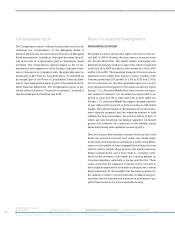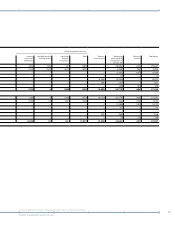Siemens 2009 Annual Report Download - page 205
Download and view the complete annual report
Please find page 205 of the 2009 Siemens annual report below. You can navigate through the pages in the report by either clicking on the pages listed below, or by using the keyword search tool below to find specific information within the annual report.-
 1
1 -
 2
2 -
 3
3 -
 4
4 -
 5
5 -
 6
6 -
 7
7 -
 8
8 -
 9
9 -
 10
10 -
 11
11 -
 12
12 -
 13
13 -
 14
14 -
 15
15 -
 16
16 -
 17
17 -
 18
18 -
 19
19 -
 20
20 -
 21
21 -
 22
22 -
 23
23 -
 24
24 -
 25
25 -
 26
26 -
 27
27 -
 28
28 -
 29
29 -
 30
30 -
 31
31 -
 32
32 -
 33
33 -
 34
34 -
 35
35 -
 36
36 -
 37
37 -
 38
38 -
 39
39 -
 40
40 -
 41
41 -
 42
42 -
 43
43 -
 44
44 -
 45
45 -
 46
46 -
 47
47 -
 48
48 -
 49
49 -
 50
50 -
 51
51 -
 52
52 -
 53
53 -
 54
54 -
 55
55 -
 56
56 -
 57
57 -
 58
58 -
 59
59 -
 60
60 -
 61
61 -
 62
62 -
 63
63 -
 64
64 -
 65
65 -
 66
66 -
 67
67 -
 68
68 -
 69
69 -
 70
70 -
 71
71 -
 72
72 -
 73
73 -
 74
74 -
 75
75 -
 76
76 -
 77
77 -
 78
78 -
 79
79 -
 80
80 -
 81
81 -
 82
82 -
 83
83 -
 84
84 -
 85
85 -
 86
86 -
 87
87 -
 88
88 -
 89
89 -
 90
90 -
 91
91 -
 92
92 -
 93
93 -
 94
94 -
 95
95 -
 96
96 -
 97
97 -
 98
98 -
 99
99 -
 100
100 -
 101
101 -
 102
102 -
 103
103 -
 104
104 -
 105
105 -
 106
106 -
 107
107 -
 108
108 -
 109
109 -
 110
110 -
 111
111 -
 112
112 -
 113
113 -
 114
114 -
 115
115 -
 116
116 -
 117
117 -
 118
118 -
 119
119 -
 120
120 -
 121
121 -
 122
122 -
 123
123 -
 124
124 -
 125
125 -
 126
126 -
 127
127 -
 128
128 -
 129
129 -
 130
130 -
 131
131 -
 132
132 -
 133
133 -
 134
134 -
 135
135 -
 136
136 -
 137
137 -
 138
138 -
 139
139 -
 140
140 -
 141
141 -
 142
142 -
 143
143 -
 144
144 -
 145
145 -
 146
146 -
 147
147 -
 148
148 -
 149
149 -
 150
150 -
 151
151 -
 152
152 -
 153
153 -
 154
154 -
 155
155 -
 156
156 -
 157
157 -
 158
158 -
 159
159 -
 160
160 -
 161
161 -
 162
162 -
 163
163 -
 164
164 -
 165
165 -
 166
166 -
 167
167 -
 168
168 -
 169
169 -
 170
170 -
 171
171 -
 172
172 -
 173
173 -
 174
174 -
 175
175 -
 176
176 -
 177
177 -
 178
178 -
 179
179 -
 180
180 -
 181
181 -
 182
182 -
 183
183 -
 184
184 -
 185
185 -
 186
186 -
 187
187 -
 188
188 -
 189
189 -
 190
190 -
 191
191 -
 192
192 -
 193
193 -
 194
194 -
 195
195 -
 196
196 -
 197
197 -
 198
198 -
 199
199 -
 200
200 -
 201
201 -
 202
202 -
 203
203 -
 204
204 -
 205
205 -
 206
206 -
 207
207 -
 208
208 -
 209
209 -
 210
210 -
 211
211 -
 212
212 -
 213
213 -
 214
214 -
 215
215 -
 216
216 -
 217
217 -
 218
218 -
 219
219 -
 220
220 -
 221
221 -
 222
222 -
 223
223 -
 224
224 -
 225
225 -
 226
226 -
 227
227 -
 228
228 -
 229
229 -
 230
230 -
 231
231 -
 232
232 -
 233
233 -
 234
234 -
 235
235 -
 236
236 -
 237
237 -
 238
238 -
 239
239 -
 240
240 -
 241
241 -
 242
242 -
 243
243 -
 244
244 -
 245
245 -
 246
246 -
 247
247 -
 248
248 -
 249
249 -
 250
250 -
 251
251 -
 252
252 -
 253
253 -
 254
254 -
 255
255 -
 256
256 -
 257
257 -
 258
258 -
 259
259 -
 260
260 -
 261
261 -
 262
262 -
 263
263 -
 264
264 -
 265
265 -
 266
266 -
 267
267 -
 268
268 -
 269
269 -
 270
270 -
 271
271 -
 272
272 -
 273
273 -
 274
274 -
 275
275 -
 276
276 -
 277
277 -
 278
278 -
 279
279 -
 280
280 -
 281
281 -
 282
282 -
 283
283 -
 284
284 -
 285
285 -
 286
286 -
 287
287 -
 288
288 -
 289
289 -
 290
290 -
 291
291 -
 292
292 -
 293
293 -
 294
294 -
 295
295 -
 296
296 -
 297
297 -
 298
298 -
 299
299 -
 300
300 -
 301
301 -
 302
302 -
 303
303 -
 304
304 -
 305
305 -
 306
306 -
 307
307 -
 308
308 -
 309
309 -
 310
310 -
 311
311 -
 312
312 -
 313
313 -
 314
314 -
 315
315 -
 316
316 -
 317
317 -
 318
318 -
 319
319 -
 320
320 -
 321
321 -
 322
322
 |
 |

117
folio, we should be able to achieve organic growth in revenue
in 2011. We plan to achieve revenue of approximately €25 bil-
lion in fiscal 2011 from the sale of environmentally friendly
products and services.
Due particularly to the anticipated lower revenue, Total Sectors
profit in fiscal 2010 is expected to decline compared to fiscal
2009. We expect Total Sectors profit between €6.0 and €6.5 bil-
lion in fiscal 2010, and an increase of approximately 20% in in-
come from continuing operations compared to €2.457 billion
in the prior year. For fiscal 2011, we expect that Siemens could
benefit from tailwinds from a recovering world economy.
One of our most important goals is to increase Siemens’ capital
efficiency. We measure achievement of this goal via return on
capital employed (ROCE), which is the ratio of income from
continuing operations before interest to average capital em-
ployed, minus the balance of assets and liabilities held for dis-
posal related to discontinued operations. Our midterm goal for
ROCE is between 14% and 16%. This goal is based on normal
business cycles. We therefore do not expect to reach it in fiscal
2010. We expect that ROCE development follows the expected
income development in fiscal 2010 and 2011.
Financial position
We expect Free cash flow to decrease in fiscal 2010 compared
to fiscal 2009, which benefited strongly from reduction of in-
ventories, particularly in the fourth quarter and collection of
receivables. Thereby Free cash flow showed a clear seasonal
development through the fiscal year. Furthermore, fiscal 2010
Free cash flow could be burdened by changing customer
behavior regarding prepayments. We consider the possibility
of declining billings in excess of cost, which would continue a
trend in parts of our project business existing for several quar-
ters. Over the business cycle, we aim to ensure that the ratio of
Free cash flow to earnings (the cash conversion rate) is greater
than one minus our rate of revenue growth adjusted for port-
folio and currency effects.
Two key factors influencing Free cash flow are management of
net working capital within cash provided by or used in operating
activities, and additions to intangible assets, property, pant and
equipment within cash used in investing activities. In principle
we aim to achieve a ratio of investments in intangible assets
and fixed assets to depreciation and amortization expense in a
range from 95% to 115%. We will retain our stringent approval
process for capital expenditures, which goes up to the Manag-
ing Board level and takes into account the macroeconomic envi-
ronment and the development of new orders. In fiscal 2010, we
aim to keep our combined Sectors in the lower end of the range.
In the area of investment planning, the Industry Sector intends
to focus on investments in new products for automation and
drive solutions, building technologies and lighting solutions.
In addition, Industry will pursue selected investments in equip-
ment replacement and rationalization. The Energy Sector plans
continued investments mainly in expanding its capacity in ma-
jor sales markets and emerging economies. The Healthcare
Sector plans to continue investing in development of software
and IT solutions, primarily relating to imaging systems, and in
developing its markets for clinical diagnostics solutions.
For our medium-term capital structure, we seek a ratio of ad-
justed industrial net debt to adjusted EBITDA in the range of
0.8 to 1.0. In fiscal 2010, we expect the ratio to increase com-
pared to fiscal 2009.
Managing Board statements, Independent auditors’ report, Additional information
95 Net assets position 97 Report on post-balance sheet date events
98 Risk report
108 Information required pursuant to
§315 (4) HGB of the German Commercial
Code and explanatory report
114 Compensation report
114 Report on expected developments
